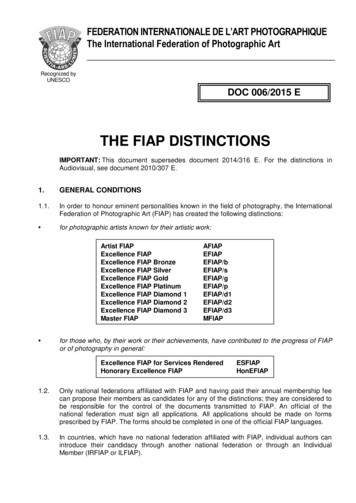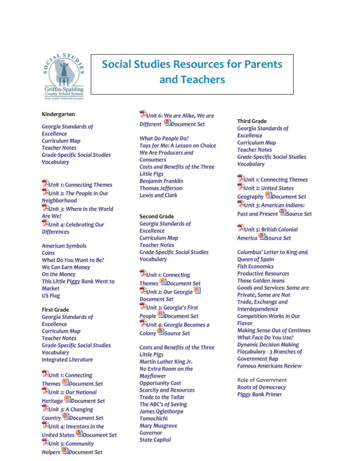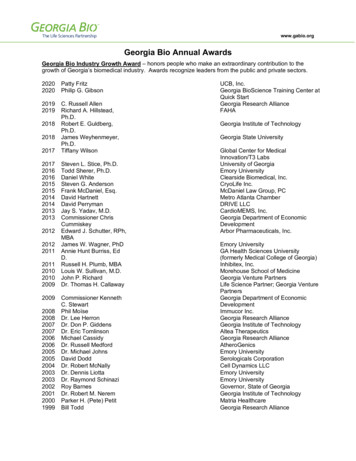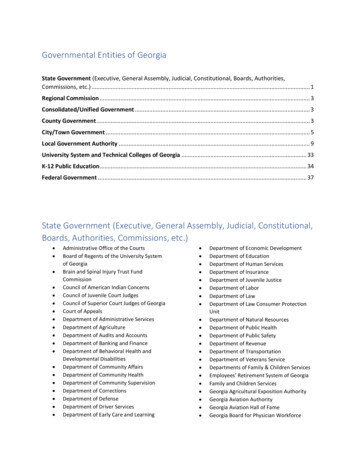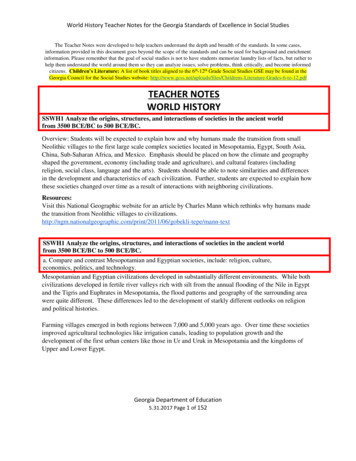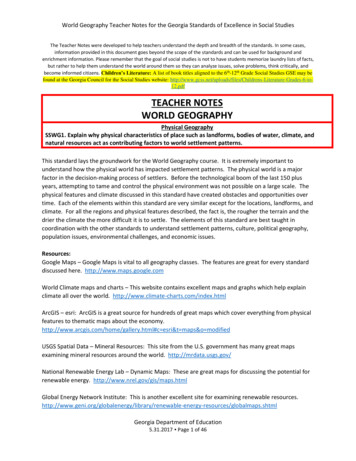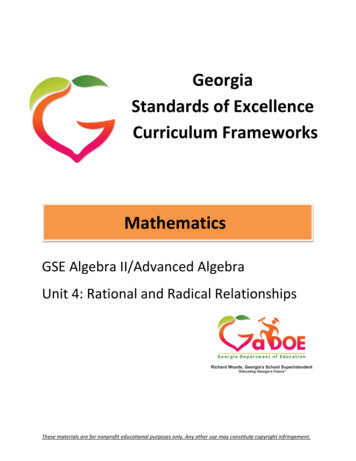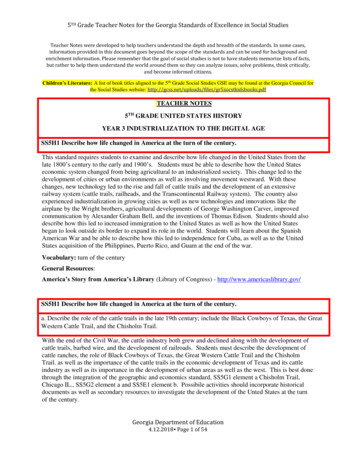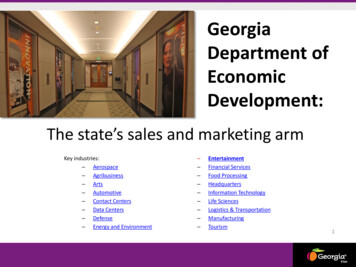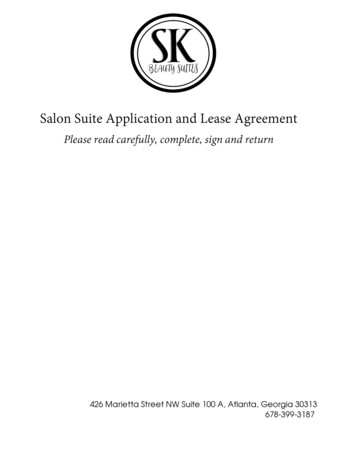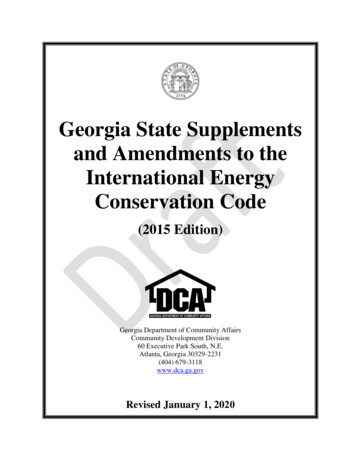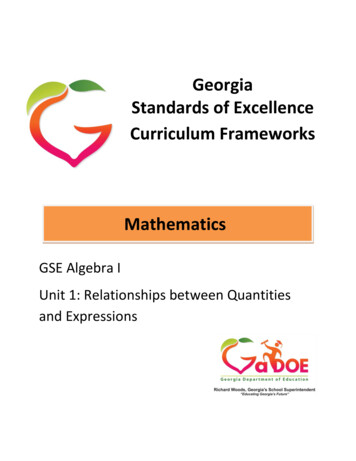
Transcription
GeorgiaStandards of ExcellenceCurriculum FrameworksMathematicsGSE Algebra IUnit 1: Relationships between Quantitiesand Expressions
Georgia Department of EducationGeorgia Standards of Excellence FrameworkGSE Algebra I Unit 1Unit 1Relationships between Quantities and ExpressionsTable of ContentsOVERVIEW . 3STANDARDS ADDRESSED IN THIS UNIT . 4ENDURING UNDERSTANDINGS . 5ESSENTIAL QUESTIONS . 6CONCEPTS AND SKILLS TO MAINTAIN . 6SELECTED TERMS AND SYMBOLS . 7EVIDENCE OF LEARNING . 9TEACHER RESOURCES . 10Web Resources . 11FORMATIVE ASSESSMENT LESSONS (FAL) . 12SPOTLIGHT TASKS . 123–ACT TASKS. 12TASKS. 13Interpreting Algebraic Expressions (Formative Assessment Lesson) . 15Polynomial Patterns (Scaffolding Task) . 16Modeling (Performance Task) . 22Yogurt Packaging (Career and Technical Education Task) . 30Corn and Oats (Career and Technical Education Task) . 32Leaky Faucet (Spotlight Task) . 34Visualizing Square Roots (Learning Task) . 39Rational & Irrational Numbers – 1 (Formative Assessment Lesson) . 46Rational & Irrational Numbers - 2 (Formative Assessment Lesson) . 47Amusement Park Problem (Culminating Task). 48ADDITIONAL TASKS . 54The Physics Professor (Illustrative Mathematics Task) . 54Delivery Trucks (Illustrative Mathematics Task) . 55Kitchen Floor Tiles (Illustrative Mathematics) . 56Mathematics GSE Algebra I Unit 1: Relationships between Quantities and ExpressionsJuly 2019 Page 2 of 56
Georgia Department of EducationGeorgia Standards of Excellence FrameworkGSE Algebra I Unit 1OVERVIEWIn this unit students will: Use units of measure (linear, area, capacity, rates, and time) as a way to understandproblems. Interpret units in the context of the problem. Convert units and rates using dimensional analysis (English–to–English and Metric–to–Metric without conversion factor provided and between English and Metric withconversion factor); Identify the different parts of the expression or formula and explain their meaning. Decompose expressions and make sense of the multiple factors and terms by explaining themeaning of the individual parts. Understand similarities between the system of polynomials and the system of integers. Understand that the basic properties of numbers continue to hold with polynomials. Draw on analogies between polynomial arithmetic and base–ten computation, focusing onproperties of operations, particularly the distributive property. Operate with polynomials with an emphasis on expressions that simplify to linear orquadratic forms. Rewrite (simplify) expressions involving radicals. Use and explain properties of rational and irrational numbers. Explain why the sum or product of rational numbers is rational; why the sum of a rationalnumber and an irrational number is irrational; and why the product of a nonzero rationalnumber and an irrational number is irrational.In this unit, students solve problems related to unit analysis and interpret the structure ofexpressions. In real–world situations, answers are usually represented by numbers associated withunits. Units involve measurement and often require a conversion. Measurement involves bothprecision and accuracy. Estimation and approximation often precede more exact computations.Students need to develop sound mathematical reasoning skills and forms of argument to makereasonable judgments about their solutions. They should be able to decide whether a problem callsfor an estimate, for an approximation, or for an exact answer. To accomplish this goal, teachersshould provide students with a broad range of contextual problems that offer opportunities forperforming operations with quantities involving units. These problems should be connected toscience, engineering, economics, finance, medicine, or other career fields.This unit develops the structural similarities between the system of polynomials and the system ofintegers. Students draw on analogies between polynomial arithmetic and base–ten computation,focusing on properties of operations, particularly the distributive property. Students connectmultiplication of polynomials with multiplication of multi–digit integers. In this unit, students alsouse and explain properties of rational and irrational numbers and rewrite (simplify) radicalexpressions. The current unit expands students’ prior knowledge of radicals, differences betweenrational and irrational numbers, and rational approximations of irrational numbers. The propertiesof rational and irrational numbers and operations with polynomials have been included as apreparation for working with quadratic functions later in the course. This content will provide asolid foundation for all subsequent units.Mathematics GSE Algebra I Unit 1: Relationships between Quantities and ExpressionsJuly 2019 Page 3 of 56
Georgia Department of EducationGeorgia Standards of Excellence FrameworkGSE Algebra I Unit 1Although the units in this instructional framework emphasize key standards and big ideas atspecific times of the year, routine topics such as estimation, mental computation, and basiccomputation facts should be addressed on an ongoing basis. Ideas related to the eight practicestandards should be addressed constantly as well. This unit provides much needed contentinformation and excellent learning activities. However, the intent of the framework is not toprovide a comprehensive resource for the implementation of all standards in the unit. A variety ofresources should be utilized to supplement this unit. The tasks in this unit framework illustrate thetypes of learning activities that should be utilized from a variety of sources. To assure that this unitis taught with the appropriate emphasis, depth, and rigor, it is important that the “Strategies forTeaching and Learning” in the Comprehensive Course Overview and the tasks listed under“Evidence of Learning” be reviewed early in the planning process.STANDARDS ADDRESSED IN THIS UNITMathematical standards are interwoven and should be addressed throughout the year in as manydifferent units and activities as possible in order to emphasize the natural connections that existamong mathematical topics.KEY STANDARDSExtend the properties of exponents to rational exponents.MGSE9–12.N.RN.2 Rewrite expressions involving radicals and rational exponents using theproperties of exponents. (i.e., simplify and/or use the operations of addition, subtraction, andmultiplication, with radicals within expressions limited to square roots).Use properties of rational and irrational numbers.MGSE9–12.N.RN.3 Explain why the sum or product of rational numbers is rational; why the sumof a rational number and an irrational number is irrational; and why the product of a nonzerorational number and an irrational number is irrational.Reason quantitatively and use units to solve problems.MGSE9–12.N.Q.1 Use units of measure (linear, area, capacity, rates, and time) as a way tounderstand problems:a. Identify, use, and record appropriate units of measure within context, within data displays,and on graphs;b. Convert units and rates using dimensional analysis (English–to–English and Metric–to–Metric without conversion factor provided and between English and Metric withconversion factor);c. Use units within multi–step problems and formulas; interpret units of input and resultingunits of output.Mathematics GSE Algebra I Unit 1: Relationships between Quantities and ExpressionsJuly 2019 Page 4 of 56
Georgia Department of EducationGeorgia Standards of Excellence FrameworkGSE Algebra I Unit 1MGSE9–12.N.Q.2 Define appropriate quantities for the purpose of descriptive modeling. Given asituation, context, or problem, students will determine, identify, and use appropriate quantities forrepresenting the situation.MGSE9–12.N.Q.3 Choose a level of accuracy appropriate to limitations on measurement whenreporting quantities. For example, money situations are generally reported to the nearest cent(hundredth). Also, an answers’ precision is limited to the precision of the data given.MGSE9–12.A.SSE.1 Interpret expressions that represent a quantity in terms of its context.MGSE9–12.A.SSE.1a Interpret parts of an expression, such as terms, factors, and coefficients,in context.MGSE9–12.A.SSE.1b Given situations which utilize formulas or expressions with multipleterms and/or factors, interpret the meaning (in context) of individual terms or factors.Perform arithmetic operations on polynomialsMGSE9–12.A.APR.1 Add, subtract, and multiply polynomials; understand that polynomials forma system analogous to the integers in that they are closed under these operations. (For the purposeof this course, operations with polynomials will be limited to the second degree. Higher degreepolynomials will be addressed in future courses.)STANDARDS FOR MATHEMATICAL PRACTICERefer to the Comprehensive Course Overview for more detailed information about the Standardsfor Mathematical Practice.1. Make sense of problems and persevere in solving them.2. Reason abstractly and quantitatively.3. Construct viable arguments and critique the reasoning of others.4. Model with mathematics.5. Use appropriate tools strategically.6. Attend to precision.7. Look for and make use of structure.8. Look for and express regularity in repeated reasoning.ENDURING UNDERSTANDINGS The structure of expressions and the meaning of their parts in context. Appropriateness of units of measure within context.Mathematics GSE Algebra I Unit 1: Relationships between Quantities and ExpressionsJuly 2019 Page 5 of 56
Georgia Department of EducationGeorgia Standards of Excellence FrameworkGSE Algebra I Unit 1 Similarities between the system of polynomials and the system of integers. Addition, Subtraction, and Multiplication of polynomials is closed. Properties of rational and irrational numbers. Simplify and/or use the operations of addition, subtraction, and multiplication, with radicalswithin expressions limited to square roots. Visual representation of radicals.ESSENTIAL QUESTIONS How do I choose and interpret units of measure in context? How do I interpret parts of an expression in terms of context? How are polynomial operations related to operations in the real number system? How can polynomials be used to express realistic situations? How do I justify simplification of radicals using visual representations? Why is the sum or product of rational numbers rational? Why is the sum of a rational number and irrational number irrational? Why is the product of a nonzero rational number and an irrational number irrational?CONCEPTS AND SKILLS TO MAINTAINStudents may not realize the importance of unit conversion in conjunction with computation whensolving problems involving measurement. Since today’s calculating devices often display 8 to 10decimal places, students frequently express answers to a much greater degree of precision than isrequired.Measuring commonly used objects and choosing proper units for measurement are part of themathematics curriculum prior to high school. In high school, students experience a broader varietyof units through real–world situations and modeling, along with the exploration of the differentlevels of accuracy and precision of the answers.An introduction to the use of variable expressions and their meaning, as well as the use of variablesand expressions in real–life situations, is included in the Expressions and Equations Domain ofGrade 7. Working with expressions and equations, including formulas, is an integral part of thecurriculum in Grades 7 and 8.Mathematics GSE Algebra I Unit 1: Relationships between Quantities and ExpressionsJuly 2019 Page 6 of 56
Georgia Department of EducationGeorgia Standards of Excellence FrameworkGSE Algebra I Unit 1During the school–age years, students must repeatedly extend their conception of numbers. Fromcounting numbers to fractions, students are continually updating their use and knowledge ofnumbers. In Grade 8, students extend this system once more by differentiating between rationaland irrational numbers.Students are expected to have prior knowledge/experience related to the concepts and skillsidentified below. It may be necessary to pre–assess to determine whether instructional time shouldbe spent on conceptual activities that help students develop a deeper understanding of these ideas. Order of operationsAlgebraic propertiesNumber senseComputation with whole numbers and integersRadicalsRational and irrational numbersMeasuring length and finding perimeter and area of rectangles and squaresVolume and capacitySELECTED TERMS AND SYMBOLSThe following terms and symbols are often misunderstood. These concepts are not an inclusive listand should not be taught in isolation. However, due to evidence of frequent difficulty andmisunderstanding associated with these concepts, instructors should pay particular attention tothem and how their students are able to explain and apply them.The definitions below are for teacher reference only and are not to be memorized by thestudents. Students should explore these concepts using models and real life examples.Students should understand the concepts involved and be able to recognize and/or demonstratethem with words, models, pictures, or numbers.The websites below are interactive and include a math glossary suitable for high school children.Note – At the high school level, different sources use different definitions. Please preview anywebsite for alignment to the definitions given in the This web site has activities to help students more fully understand and retain new omepg.aspDefinitions and activities for these and other terms can be found on the Intermath website.Intermath is geared towards middle and high school students. Algebra: The branch of mathematics that deals with relationships between numbers,utilizing letters and other symbols to represent specific sets of numbers, or to describe apattern of relationships between numbers. Binomial Expression: An algebraic expression with two unlike terms.Mathematics GSE Algebra I Unit 1: Relationships between Quantities and ExpressionsJuly 2019 Page 7 of 56
Georgia Department of EducationGeorgia Standards of Excellence FrameworkGSE Algebra I Unit 1 Capacity: The greatest volume that a container can hold. Circumference: The distance around a circle. Coefficient: A number multiplied by a variable. Constant Term: A quantity that does not change its value. Expression: A mathematical phrase involving at least one variable and sometimesnumbers and operation symbols. Factor: When two or more integers are multiplied, each integer is a factor of the product."To factor" means to write the number or term as a product of its factors. Integer: The set of numbers .,–3,–2,–1,0,1,2,3, Irrational Number: A number whose decimal form is nonterminating and nonrepeating.Irrational numbers cannot be written in the form a/b, where a and b are integers (b cannotbe zero). So all numbers that are not rational are irrational. Monomial Expression: An algebraic expression with one term. Perimeter: The sum of the lengths of the sides of a polygon. Polynomial function: A polynomial function is defined as a function,f(x) ao xn a1 xn-1 a2 xn-2 an-2 x2 an-1 x1 an ,where the coefficients are real numbers. Pythagorean Theorem: It is a theorem that states a relationship that exists in any righttriangle. If the lengths of the legs in the right triangle are a and b and the length of thehypotenuse is c, we can write the theorem as the following equation: a 2 b 2 c 2 Radical: The symbol, 𝑎, which is read "the bth root of a," is called a radical. Radicand: The number underneath the root symbol. So, in 𝑎, the a is called the radicand. Rational Number: A number expressible in the form a/b or – a/b for some fraction a/b.The rational numbers include the integers. Standard Form of a Polynomial: To express a polynomial by putting the terms indescending exponent order. Term: A number, a variable, or a product of numbers and variables.𝑏𝑏Mathematics GSE Algebra I Unit 1: Relationships between Quantities and ExpressionsJuly 2019 Page 8 of 56
Georgia Department of EducationGeorgia Standards of Excellence FrameworkGSE Algebra I Unit 1 Trinomial: An algebraic expression with three unlike terms. Variable: A letter or symbol used to represent a number. Volume: The amount of space occupied by an object. Whole numbers: The numbers 0, 1, 2, 3, .The properties of operations. Here a, b and c stand for arbitrary numbers in a given numbersystem. The properties of operations apply to the rational number system, the real number system,and the complex number system.Associative property of addition (a b) c a (b c)Commutative property of addition a b b aAdditive identity property of 0 a 0 0 a aExistence of additive inverses For every a there exists –a so that a (–a) (–a) a 0.Associative property of multiplication (a b) c a (b c)Commutative property of multiplication a b b aDistributive property of multiplication over addition a (b c) a b a cDefinitions and activities for these and other terms can be found on the Intermath g.aspEVIDENCE OF LEARNINGBy the conclusion of this unit, students should be able to demonstrate the following competencies:. Interpret units of measure in context. Interpret parts of an expression in terms of context. Relate polynomial operations to the real number system. Use polynomials to express realistic situations. Simplify radicals and justify simplification of radicals using visual representations. Use the operations of addition, subtraction, and multiplication, with radicals withinexpressions limited to square roots. Understand why the sum or product of rational numbers is rational.Mathematics GSE Algebra I Unit 1: Relationships between Quantities and ExpressionsJuly 2019 Page 9 of 56
Georgia Department of EducationGeorgia Standards of Excellence FrameworkGSE Algebra I Unit 1 Understand why the sum of a rational number and irrational number is irrational. Understand why the product of a nonzero rational number and an irrational number isirrational. Understand that results of operations performed between numbers from a particular numberset does not always belong to the same set. For example, the sum of two irrational numbers(2 3) and (2 – 3) is 4, which is a rational number; however, the sum of a rationalnumber 2 and irrational number 3 is an irrational number (2 3)TEACHER RESOURCESThe following pages include teacher resources that teachers may wish to use for the purpose ofinstruction and assessment:- http://brightstorm.com/search/?k polynomials- Illustrative /Standards are illustrated with instructional and assessment tasks, lesson plans, and othercurriculum resources.- http://www.khanacademy.org/search?page search query polynomials For mathematical applications- http://www.thefutureschannel.com/- The Georgia Online Formative Assessment Resource (GOFAR) accessible through SLDScontains test items related to content areas assessed by the Georgia Milestones AssessmentSystem and NAEP. Teachers and administrators can utilize the GOFAR to developformative and summative assessments, aligned to the state–adopted content standards, toassist in informing daily instruction.Students, staff, and classes are prepopulated and maintained through the State LongitudinalData System (SLDS). Teachers and Administrators may view Exemplars and Rubrics inItem Preview. A scoring code may be distributed at a local level to help score constructedresponse items.Mathematics GSE Algebra I Unit 1: Relationships between Quantities and ExpressionsJuly 2019 Page 10 of 56
Georgia Department of EducationGeorgia Standards of Excellence FrameworkGSE Algebra I Unit 1For GOFAR user guides and overview, please nline–Formative–Assessment–Resource.aspxWeb ResourcesThe following list is provided as a sample of available resources and is for informational purposesonly. It is your responsibility to investigate them to determine their value and appropriateness foryour district. GADOE does not endorse or recommend the purchase of or use of any particularresource. Scale of Universehttp://scaleofuniverse.com/Fantastic applet exploring the magnitudes of the universe. Algebraic high–school–algebra–lesson?fd 1Teacher Resource: Video of a lesson showing implementation of a FAL activity. National Library of Virtual Manipulatives – Algebra Tiles. Visualize multiplying algebraicexpressions using tiles.http://nlvm.usu.edu/en/nav/frames asid 189 g 4 t 2.html?open activities&from category g4 t 2.html NASA oringmath/algebra1/Prob SuitYourself detail.htmlIn–depth lesson plan relating linear equations to space suit production.Mathematics GSE Algebra I Unit 1: Relationships between Quantities and ExpressionsJuly 2019 Page 11 of 56
Georgia Department of EducationGeorgia Standards of Excellence FrameworkGSE Algebra I Unit 1FORMATIVE ASSESSMENT LESSONS (FAL)Formative Assessment Lessons are intended to support teachers in formative assessment. Theyreveal and develop students’ understanding of key mathematical ideas and applications. Theselessons enable teachers and students to monitor in more detail their progress towards the targets ofthe standards. They assess students’ understanding of important concepts and problem solvingperformance, and help teachers and their students to work effectively together to move eachstudent’s mathematical reasoning forward.More information on Formative Assessment Lessons may be found in the Comprehensive CourseOverview.SPOTLIGHT TASKSA Spotlight Task has been added to each GSE mathematics unit in the Georgia resources formiddle and high school. The Spotlight Tasks serve as exemplars for the use of the Standards forMathematical Practice, appropriate unit–level Georgia Standards of Excellence, and research–based pedagogical strategies for instruction and engagement. Each task includes teachercommentary and support for classroom implementation. Some of the Spotlight Tasks are revisionsof existing Georgia tasks and some are newly created. Additionally, some of the Spotlight Tasksare 3–Act Tasks based on 3–Act Problems from Dan Meyer and Problem–Based Learning fromRobert Kaplinsky.3–ACT TASKSA Three–Act Task is a whole group mathematics task consisting of 3 distinct parts: an engagingand perplexing Act One, an information and solution seeking Act Two, and a solution discussionand solution revealing Act Three.More information along with guidelines for 3–Act Tasks may be found in the ComprehensiveCourse Overview.Mathematics GSE Algebra I Unit 1: Relationships between Quantities and ExpressionsJuly 2019 Page 12 of 56
Georgia Department of EducationGeorgia Standards of Excellence FrameworkGSE Algebra I Unit 1TASKSThe following tasks represent the level of depth, rigor, and complexity expected of all Algebra Istudents. These tasks, or tasks of similar depth and rigor, should be used to demonstrate evidenceof learning. It is important that all elements of a task be addressed throughout the learning processso that students understand what is expected of them. While some tasks are identified as aperformance task, they may also be used for teaching and learning (learning/scaffolding task).Task NameSuggested TimeInterpretingAlgebraicExpressions90 – 120 minTask TypeGrouping StrategyFormativeAssessment LessonPartner/SmallGroupPolynomialPatterns30 – 45 minScaffolding TaskIndividual / PartnerModeling30 minPerformance TaskSmall Group TaskYogurt Packaging45–60 minutesPDF / WordAchieve CCSS–CTEClassroom TaskIndividual/PartnerAchieve CCSS–CTEClassroom TaskSmall GroupSpotlight TaskIndividual / PartnerCorn & Oats60 minutesPDF / WordLeaky Faucet30–45 minVisualizing SquareRoots50-60 minLearning TaskIndividual/PartnerContent AddressedRecognizing the order of algebraicoperations, recognizing equivalentexpressions, and understanding thedistributive laws of multiplication anddivision over addition (expansion ofparentheses).Add, subtract, and multiply Applying Geometric Representations ofPolynomialsA.APR.1A.SSE.1aA.SSE.1bN.Q.1Convert units in order to solve problems. N.Q.1N.Q.2N.Q.3Making a scale model and makeconversions.Use units as a way to understandproblemsDefine appropriate quantities for thepurpose of descriptive modeling.Choose a level of accuracyappropriate to limitations onmeasurement when reportingquantities.To build the ideas of square and squareroot on their geometric interpretation.To justify simplification of radicalsusing geometric representations.Mathematics GSE Algebra I Unit 1: Relationships between Quantities and ExpressionsJuly 2019 Page 13 of 56N.Q.1N.Q.2N.Q.3N.Q.1N.Q.2N.Q.3N.RN.2
Georgia Department of EducationGeorgia Standards of Excellence FrameworkGSE Algebra I Unit 1Task NameSuggested TimeRational andIrrationalNumbers #160–85 minTask TypeGrouping StrategyFormativeAssessment LessonPartner/SmallGroupRational andIrrationalNumbers #260–85 minFormativeAssessment LessonPartner/SmallGroupFinding irrational and rational numbersto exemplify general statements andreasoning with properties of rational andirrational numbers.N.RN.2N.RN.3A.SSE.1aA.SSE.1bAmusement Park60–90 minCulminating TaskPartner/SmallGroup TaskReviewing of Unit .Q.2N.Q.3Additional Task:The PhysicsProfessorIllustrativeMathematics TaskExtensionInvestigating a radical expression.A.SSE.1A.SSE.1aIllustrativeMathematics TaskLooking for structure in algebraicexpressions related to a context.A.SSE.1A.SSE.1aIllustrativeMathematics TaskPracticing reading, analyzing, andconstructing algebraic expressionsarising from patterns.A.SSE.1A.SSE.1aAdditional Task:Delivery TrucksAdditional Task:Kitchen FloorTilesContent AddressedClassifying numbers as rational orirrational and moving betweendifferent representations of rationaland irrational numbers.Mathematics GSE Algebra I Unit 1: Relationships between Quantities and ExpressionsJuly 2019 Page 14 of 56StandardsN.RN.2N.RN.3A.SSE.1a
Georgia Department of EducationGeorgia Standards of Excellence FrameworkGSE Algebra I Unit 1Interpreting Algebraic Expressions (Formative Assessment Lesson)Back to Task TableSource: Formative Assessment Lesson Materials from Mathematics Assessment .php?fileid 694Essential Questions How do you recognize the order of algebraic operations? How do you recognize equivalent expressions? How do you understand the distributive laws of multiplication and division over addition(expansion of parentheses)?Task CommentsTasks and lessons from the Mathematics Assessment Project are specifically designed to helpteachers effectively formatively assess their students. The way the tasks and lessons are designedgives the teacher a clear understanding of what the students are able to do and not do. Within thelesson, teachers will find suggestions and question prompts that will help guide students towardsunderstanding. For more information access the MAP kground.php?subpage formativeThe task, Interpreting Algebraic Expressions, is a Formative Assessm
GSE Algebra I Unit 1 Mathematics 1GSE Algebra I Unit : Relationships between Quantities and Expressions July 2019 Page 3 of 56 OVERVIEW In this unit students will: Use units of measure (linear, area, capacity, rates, and time) as a way to understand p
